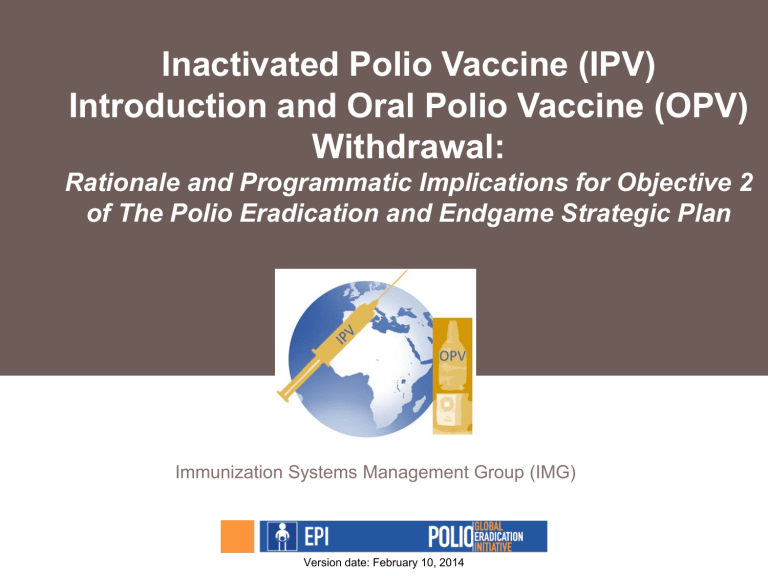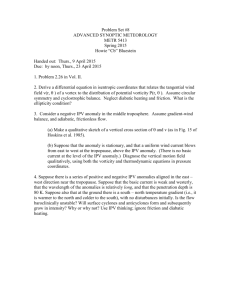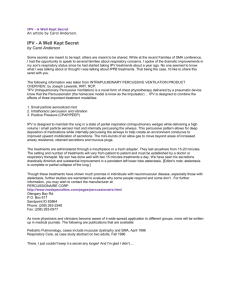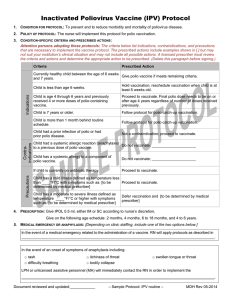Inactivated Polio Vaccine (IPV) Introduction and Oral Polio Vaccine (OPV) Withdrawal:

Inactivated Polio Vaccine (IPV)
Introduction and Oral Polio Vaccine (OPV)
Withdrawal:
Rationale and Programmatic Implications for Objective 2 of The Polio Eradication and Endgame Strategic Plan
Immunization Systems Management Group (IMG)
Version date: February 10, 2014
Glossary of terms & abbreviations
cVDPV
DTP3
GPEI
IMG
Circulating Vaccine-Derived Poliovirus
Diphtheria Tetanus Pertussis (third dose)
Global Polio Eradication Initiative
VDPV
WHA
WHO
WPV
Immunization Systems Management Group
IPV
OPV
tOPV
OPV2
(trivalent, contains types 1, 2 and 3)
bOPV (bivalent, contains types 1 and 3)
mOPV 1, 2 or 3 (monovalent, types 1, 2 or 3)
Type 2 oral polio vaccine
SAGE
VAPP
Inactivated Polio Vaccine
Oral polio vaccine
Strategic Advisory Group of Experts on Immunization
Vaccine-associated paralytic poliomyelitis
Vaccine-derived poliovirus
World Health Assembly
World Health Organization
Wild poliovirus
4/12/2020 2
Objectives
1.
Provide background on Polio & Polio vaccines as it relates to Objective
2 of GPEI’s Polio Eradication & Endgame Strategic Plan
− SAGE recommendations
2.
Programmatic implications of IPV introduction
Partner coordination & technical assistance
IPV Vaccine Presentation
Country readiness
Supply & Price
Communications
3.
GAVI Policies and Processes
4/12/2020 3
GPEI Accomplishment: Significant decline in number of persons paralyzed by wild polioviruses, 1988-2013*
400
300
200
1800
1600
1400
1200
1000
800
600
400
200
0
1604
2009
1352
2010
650
2011
230
369
2012 2013
100
Last case of type 2 polio
0
*as of 31 Dec 2013; case count will be updated regularly ( current numbers: http://www.polioeradication.org/Dataandmonitoring/Poliothisweek.aspx
4/12/2020 4
Types of polioviruses
Wild
• 99% reduction in cases of wild poliovirus since 1988
• Type 1 (369 cases as of 31 December 2013†)
• Type 2 (eliminated worldwide in 1999)
• Type 3 (none detected since November 2012)
VAPP**
• Vaccine-associated paralytic poliomyelitis (VAPP)**
• Estimated ~250-500 globally per year
• Type 2 accounts for about 40% of VAPP
VDPVs*
• Vaccine derived polioviruses (VDPV)
• Most are circulating VDPVs (cVDPVs)*
• ~58-184 per year since 2008 (through 31 Dec 2013)
• Type 2 cVDPVs account for 97% of cVDPVs
† More up-to-date numbers can be found at http://www.polioeradication.org/Dataandmonitoring/Poliothisweek.aspx
*Other extremely rare VDPVs include primary immunodeficiency VDPVs (iVDPVs) and ambiguous VDPVs (aVDPVs)
**Refers to spontaneous reversion to neurovirulence of one of the attenuated viruses in OPV. VAPP occurs in OPV recipients or their close contacts in contrast to cVDPVs which are widely transmitted in a community and are not likely to be related to contact with a recent vaccine recipient.
4/12/2020 5
As wild polioviruses are eradicated, number of circulating vaccinederived cases exceeds wild poliovirus cases
4/12/2020
800
600
400
200
0
1800
1600
1400
1200
1000
1604
2009
1352
650
230
369
Wild poliovirus cases
Vaccine-derived poliovirus cases (VDPVs)/VAPP
2010 2011 2012 2013 2014
0
2015
0
2016
0
2017
0
2018
Post interruption of WPV transmission
Estimated VDPV cases compared to reported cases of wild poliovirus (as of 31 December, 2013)
6
4/12/2020
Last type 2 wild poliovirus: 1999 however…..
7
circulating Vaccine-Derived Poliovirus
Outbreaks (cVDPVs), 2000-2011
4/12/2020
>90% of cVDPV polio cases are due to type 2
Type 1 (79 cases)
Type 2 (478 cases)
Type 3 (9 cases)
8
Vaccine virus outbreaks, last 6 months
All recent cVDPV outbreaks are due to Type 2 virus
4/12/2020 9
The Polio Eradication & Endgame Strategic Plan 2013-2018
The Plan differs from previous eradication plans because it addresses paralytic cases associated with both wild polioviruses and vaccine-derived poliovirus/VAPP
Eradication
• refers to wild virus
Endgame
• refers to management of
VDPVs and VAPP
10 4/12/2020
Goal: to complete the eradication & containment of all wild, vaccine-related and Sabin polioviruses.
4/12/2020 11
The Plan has Four Objectives
1 • Detect and interrupt all poliovirus transmission
2
3
• Strengthen immunization systems, introduce inactivated polio vaccine (IPV) and withdraw oral polio vaccines (OPV)
• Contain poliovirus and certify interruption of transmission
4 • Plan polio’s legacy
4/12/2020 12
Objective 2 of The Plan addresses the Endgame through three distinct stages
2019-2020
2016
Before end
2015
Switch
• tOPV to bOPV
Introduce
• at least one dose of IPV
• into routine immunization
Withdraw
• of bOPV & routine OPV use
4/12/2020
Ongoing STRENGTHENING of routine immunization services
13
Contribute to the strengthening of routine immunisation
Plan for, implement and monitor the use of polio assets for routine immunisation strengthening
Human (e.g. polio staff supported by GPEI in WHO and UNICEF)
Physical (e.g. vehicles)
Systems/Networks (e.g. surveillance and monitoring data)
Experience (e.g. microplanning)
Concentrate on the country level
Assets are concentrated in key countries, all priorities for the broader immunisation agenda
Use existing cMYPs / annual plans to guide interventions; support should be implemented based on national context and priorities
Develop flexible 'packages' of potential support interventions that teams can use to plan, based on team assets, experience and areas of expertise
14 4/12/2020
Endgame targets for routine immunisation strengthening
Support the development of/build on national coverage improvement plans as an integral part of the national inmunisation plans in 10 focus countries by end 2014.
Dedicate >50% of poliofunded field personnel’s time in the focus countries to immunisation systems strengthening tasks.
Achieve 10% (relative) year-on-year improvement in DTP3 coverage rates in high-risk districts in 10 focus countries beginning in 2014.
4/12/2020 15
Rationale for introducing at least one dose of IPV prior to the tOPV-bOPV switch
IPV protects children against poliovirus types 1, 2 and 3. Introducing IPV prior to the tOPV-bOPV switch will maximize the proportion of the population protected against type 2 polio after OPV2 cessation. One dose of IPV will:
Reduce risks associated with type 2 cessation
Lower risk of re-emergence of type 2 polioviruses
Facilitate interruption of transmission with the use of monovalent OPV2 if type 2 outbreaks occur
Boost immunity against types 1
& 3 thus hastening polio eradication
Interrupt transmission if outbreaks occur
Reduce risks
IPV
Hasten eradication
4/12/2020 16
Planned use of IPV: SAGE Recommendations
• SAGE recommended that all countries introduce at least 1 dose of IPV in their routine immunization programmes to mitigate the risks associated with the withdrawal of type 2 component of OPV
• Single dose of IPV at 14 weeks of age with DTP3, in addition to OPV3 or OPV4.
• Countries have flexibility to consider alternative schedules
• All endemic and other high risk countries should develop a plan for IPV introduction by mid-2014 and all
OPV-only using countries by end-2014
Summary of SAGE Meeting at http://www.who.int/immunization/sage/report_summary_november_2013/en/index.html
4/12/2020 17
Rationale for administering IPV after 14 weeks of age, in the context of the Endgame Plan
The immune response to intramuscularly administered IPV varies based on the number of administered doses (higher with more doses) and the age at vaccination (higher with delayed immunization).
3 doses: ~100% against all 3 serotypes
2 doses: ~90% against all 3 serotypes, when administered >8 weeks of age
1 dose: ~19%-46% against Type 1,
32%-63% against Type 2, and 28%-54% against Type 3 poliovirus.
The immune response to one dose of IPV is substantially higher against
Type 2 poliovirus (63%) when administered at 4 months of age compared to
6 weeks to 2 months of age (32%-39%).
Thus, SAGE recommends a single dose of IPV at 14 weeks or first contact afterwards, or with DTP3/OPV3/OPV4, in the EPI schedule
18 4/12/2020
Rationale for SWITCH from tOPV to bOPV in 2016
Risks of OPV2 far outweigh the benefits
Thus, need to remove OPV2, but need to maintain population immunity against type 2 with IPV prior to OPV2 cessation
Type 2 wild poliovirus apparently eradicated since 1999 (last case detected in Aligarh, India)
New diagnostics and experience suggest that type 2 polio vaccine causes >95% of VDPVs
Type 2 causes approximately 40% of VAPP today
Type 2 component of OPV interferes with immune response to types 1 and types 3
19 4/12/2020
Pre-requisites for tOPV-bOPV switch
Validation of persistent cVDPV2 elimination and WPV2 eradication
Stockpile of mOPV2 and response capacity (and guidelines)
Surveillance and international notification of Sabin, Sabin-like and cVDPV2
Availability of licensed bOPV in all OPV-using countries
Affordable IPV options for all OPV using countries
Containment phase II for cVDPV2 and WPV2 and phase I for Sabin type 2
4/12/2020 20
Key messages for IPV introduction & OPV withdrawal
IPV recommended by
SAGE
• All countries introduce at least one dose of IPV into the routine immunization system before the tOPV-bOPV switch
OPV withdrawal crucial
OPV withdrawal —
Two phases
IPV rationale
Added IPV benefits
IPV clarifications
•
OPV withdrawal must occur for the world to be polio free because OPV in rare cases can cause paralytic disease
• Removal of type 2 in 2016 ( tOPV to bOPV switch globally)
• bOPV cessation in 2018-2019 ( complete withdrawal of
OPV )
• Ensures that a substantial proportion of the population is protected against type 2 polio after OPV2 cessation
• Mitigates risks of type 2 reintroduction in association with
OPV2 cessation & facilitates polio eradication by boosting immunity to types 1&3
• Recommended for routine immunization …not campaigns
• Recommended in addition to OPV …not replacing any OPV doses
4/12/2020 21
4/12/2020
Programmatic Implications of
IPV Introduction
22
4/12/2020
OPV only
(Announced future IPV introduction)
IPV only using
Sequential (IPV + OPV)
124
(1)
50
20
23
Introducing in 124 countries warrants a coordinated multi-partner effort to ensure policies and provide technical assistance to countries
• Oversight group jointly chaired by WHO and UNICEF
• Membership from core GPEI partners & GAVI:
• CDC
• Rotary International
• Bill & Melinda Gates Foundation (BMGF)
• WHO and UNICEF (HQ and regional level)
• GAVI
4/12/2020 24
IPV Presentations and Formulations
Stand-alone
IPV
Combination products
• Only WHO prequalified formulation*
• 1-dose and 10-dose available now
• 5-dose expected in late 2014
• Preservative: 2-phenoxyethanol does not meet WHO requirements for an effective preservative (a multidose vial, once opened, must be discarded after 6 hours or at the end of an immunization session)
• Tetravalent, pentavalent, hexavalent available
• Combination with whole-cell pertussis not available
• Substantially higher cost than stand-alone IPV
($37-$80 per dose in the US**)
4/12/2020
*http://www.who.int/immunization_standards/vaccine_quality/PQ_vaccine_list_en/en/
*http://www.cdc.gov/vaccines/programs/vfc/awardees/vaccine-management/price-list/index.html
25
Considerations for Planning and Logistics
Coordination with other introductions
• Many countries have planned introductions for other new vaccines (e.g., rotavirus, PCV) so need coordinated effort
Multi Dose Vial Policy
(MDVP)
• IPV can only be kept for 6 hours or until the end of the vaccination session once the vial is opened
High Wastage Rates • 50% for 10-dose vial and 30% for 5-dose vial
Licensing
Cold chain
Acceptability
• IPV must be licensed in country or country must accept WHO prequalified product
•
Limited impact on cold chain due to addition of IPV, but may be challenging in context of other introductions
• IPV would represent 2 nd or 3 rd injection at DTP3 contact; possible confusion around role of IPV versus role of OPV
4/12/2020 26
IPV Impact on central level cold chain is limited
• Figure shows that estimated impact of one dose vial of IPV is limited on cold chain in DRC
• If countries ’ systems already stressed, and introduction of IPV and other new vaccines is an opportunity to address issues and constraints
• Volume per dose is roughly similar to measles vaccine:
• 10-dose: 2.46cm
3
• 1-dose: 15.7 cm 3
DRC
Vaccine Volumes per FIC (cm3)
27 4/12/2020
Pilot introductions, training materials, and deployable consultants
Discussions with all WHO & UNICEF regional offices to engage countries
Planning for possible “Pilot Countries" (early 2014)
Objective would be early identification of operational issues associated with IPV introduction and its impact on the existing immunization system in the countries, so that they can be corrected and shared with other countries
Ensuring in-country registration of stand-alone IPV or that WHO prequalification is accepted
Development of NITAG & training materials underway
Planning training of cadre of deployable training consultants that would be available to provide technical assistance to countries
Case studies ongoing to share experience from countries with “dual” new vaccine introductions and issues related to multiple injections
4/12/2020 28
IPV webpages live: http://www.who.int/immunization/diseases/poliomyelitis/inactivated_polio_vaccine/en/index.html
4/12/2020 29
Communications & Advocacy: Fact Sheets, FAQs, slides sets, and technical documents available on the IPV website
4/12/2020 30
Vaccine Demand Forecast & Supply
GPEI has ensured sufficient production capacity for current IPV standalone products to meet the needs of all OPV using countries to introduce one dose of IPV into their routine immunization programme
Initial global demand forecast: 580-624 million doses needed by 2018
However, to ensure sufficient IPV is available when countries are ready to introduce, it is essential that all countries define target introduction dates no later than mid-end 2014
Four manufacturers currently produce stand-alone IPV
Sanofi- Pasteur, France (SP)
Serum Institute of India (SII)
GlaxoSmithKline, Belgium (GSK)
Statens Serum Institut, Denmark (SSI)
4/12/2020 31
Vaccine Demand Forecast & Supply
GPEI has ensured sufficient production capacity for current IPV standalone products to meet the needs of all OPV using countries to introduce one dose of IPV into their routine immunization programme
Initial global demand forecast: 580-624 million doses needed by 2018
However, to ensure sufficient IPV is available when countries are ready to introduce, it is essential that all countries define target introduction dates no later than mid-end 2014
Four manufacturers currently produce stand-alone IPV
Sanofi- Pasteur, France (SP)
Serum Institute of India (SII)
GlaxoSmithKline, Belgium (GSK)
Statens Serum Institut, Denmark (SSI)
4/12/2020 32
Vaccine Demand Forecast & Supply
Countries should plan for 6-9 months lead time from the time their introduction plan is finalised (or recommended through the GAVI application process).
For countries procuring through UNICEF, the actual timing of supply will be confirmed country by country, based on product preference, country size, licensing requirements and overall supply and demand.
Countries can contact UNICEF Supply Division through the
UNICEF Country Office for further information.
4/12/2020 33
IPV Price – Current & Future
GPEI partners are working towards achieving the lowest possible price for GAVI and non-GAVI countries . Final prices for all countries will be communicated following awards of the UNICEF tender in Q1. It is expected that further reductions in price may be achieved
CURRENT Public Sector Price for IPV ranges from ~$2 to $12
Country Vaccine Cost per dose
USA 1
PAHO 2
UNICEF tender prior to 2014 ( DOES
NOT refer to new tender discussions which are ongoing ) 3
Sanofi (10 dose vial)
GSK (1 dose)
Bilthoven (1 dose)
GSK (1 dose)
Sanofi (10 dose vial)
SSI (1 dose)
$12.42
$4.14
$2.90
$4.14
$2.25 - $2.70
$5.70
4/12/2020
1.
http://www.cdc.gov/vaccines/programs/vfc/awardees/vaccine-management/price-list/index.html
2.
http://www.paho.org/hq/index.php?option=com_content&view=article&id=1864&Itemid=2234&lang=en
3.
http://www.unicef.org/supply/index_66260.html
34
4/12/2020
Policy Aspects Related to IPV
GAVI-GPEI Partnership on Introduction of IPV
35
GAVI – GPEI Partnership
GPEI and the GAVI Alliance recognise the importance of strong partnership and complementarity ; partners are now working together to improve coordination and strengthen routine immunisation services
In June 2013, the GAVI Alliance Board supported GAVI playing a lead role in the introduction of IPV into the routine immunisation programs in all 73 eligible and graduating GAVI countries .
On 22 November 2013, the GAVI Alliance Board approved to support introduction of IPV i n the world’s 73 poorest countries, including adjustments to GAVI policies and processes to facilitate meeting GPEI’s accelerated introduction timelines for IPV.
4/12/2020 36
GAVI support for IPV
GAVI Alliance Board decisions November 2013
Eligibility
Immunisation coverage filter
Duration of support
• 73 GAVI eligible and graduating countries.
• Requirement to have 70% DTP3 coverage before applying for vaccine support does not apply
• Until 2024 (subject to funding beyond 2018)
Application submission window
• Until June 2015 with introduction targeted by end 2015
Co-financing
• All countries exempted even if country is in default; however co-financing still recommended
4/12/2020
Introduction grant • GAVI countries eligible for vaccine introduction grant
*All policy exceptions to be reviewed in 2018
37
Application documents for IPV
The GAVI IPV application guidelines includes information on the requirements, processes and timelines to support applications submitted by 30 March 2014.
The following documents must be completed and submitted to proposals@gavialliance.org
when applying for IPV:
Annex A. IPV introduction plan
Annex B. IPV application form
Annex C. IPV introduction timeline of activities
Annex D. Budget and financing for IPV introduction
All of the above materials are available from your GAVI focal point or the GAVI web site at: http://www.gavialliance.org/support/apply/
Updated application guidelines will be available for countries submitting after 30 March 2014.
4/12/2020 38
Application timelines for IPV and all GAVI support
in 2014* http://www.gavialliance.org/support/apply/
For IPV only
For all new vaccines, IPV and health systems strengthening
Expression of Interest cut-off dates
Application submission cut-off dates
N/A
N/A
6 February
30 March
Independent
Review
Committee dates
27 February – 7
March
28 – 30 April
GAVI CEO or
Executive
Committee decision
Within four weeks of the IRC
Guidelines and forms to be used for applications
Available now on GAVI web site
1 March
1 May 23 June – 4 July
September 2014.
For IPV only, four weeks after IRC review.
Materials to be published in
15 May
15 September
10 – 21
November
For IPV only, four weeks after IRC review.
4/12/2020 *2015 schedule to be determined 39
GAVI support for IPV: actions for countries
Countries are encouraged to continue discussions on IPV introduction in the routine immunisation programme and on switching OPV
Discussions should take into account:
The timelines of the Endgame Plan
Action needed on key technical steps, such as licensure of IPV and bOPV in your country, and cold chain and routine immunisation program improvements
WHO, UNICEF, and the entire GAVI Alliance are committed to supporting your efforts to strengthen routine immunisation
4/12/2020 40
Key Dates Relevant to Objective 2, 2014-2020
Date Timeline
Mid 2014 All endemic countries to define their target IPV introduction dates
End 2014 All OPV-using countries to define their target IPV introduction dates
End 2015 All countries to introduce at least 1 dose of IPV into routine immunization schedule
May 2015 WHA resolution on target date for OPV2 cessation
2016 Synchronized global tOPV-bOPV switch
2018 Global certification of polio eradication
2019-2020 Complete withdrawal of bOPV
4/12/2020 41
IPV is more than a vaccine. . .
I – “Important”
P – “Progress”
V – “Vital”
IPV introduction is important, represents progress, and is vital for eradicating polio and opening the door to protect children from other serious diseases.
42 4/12/2020



